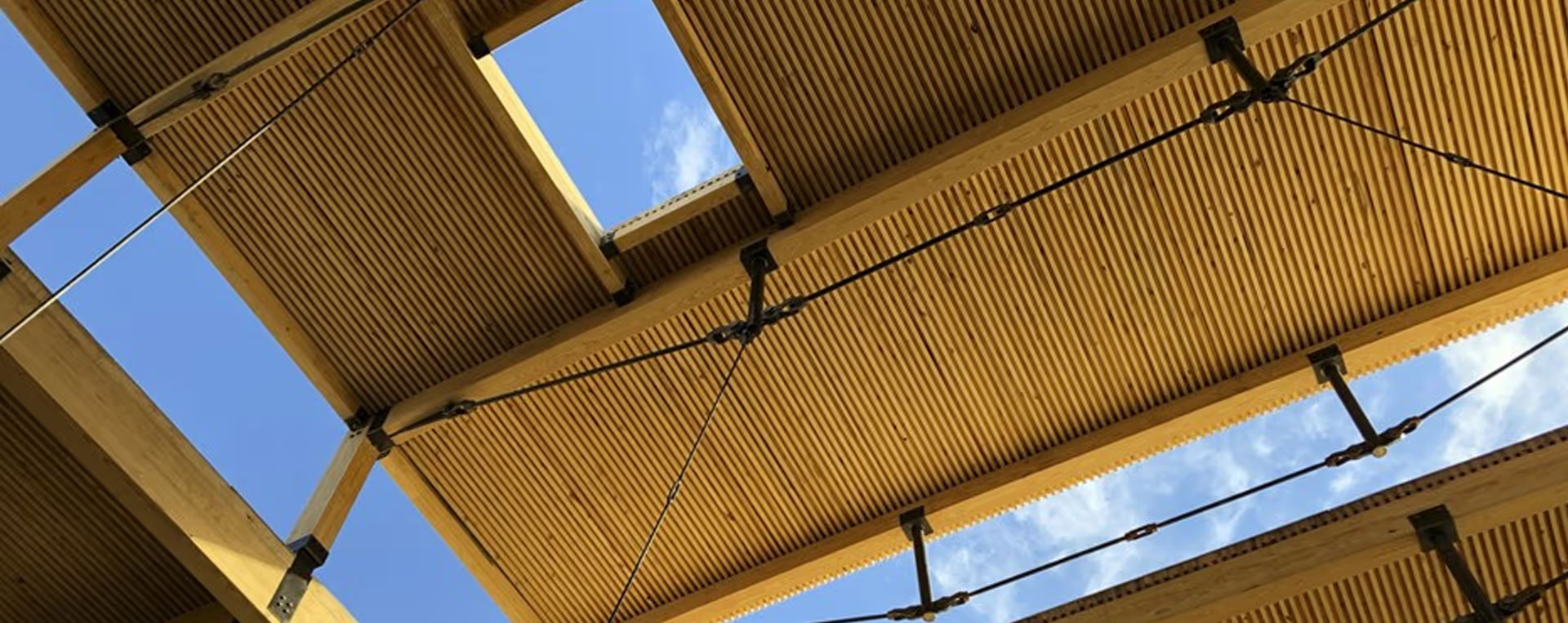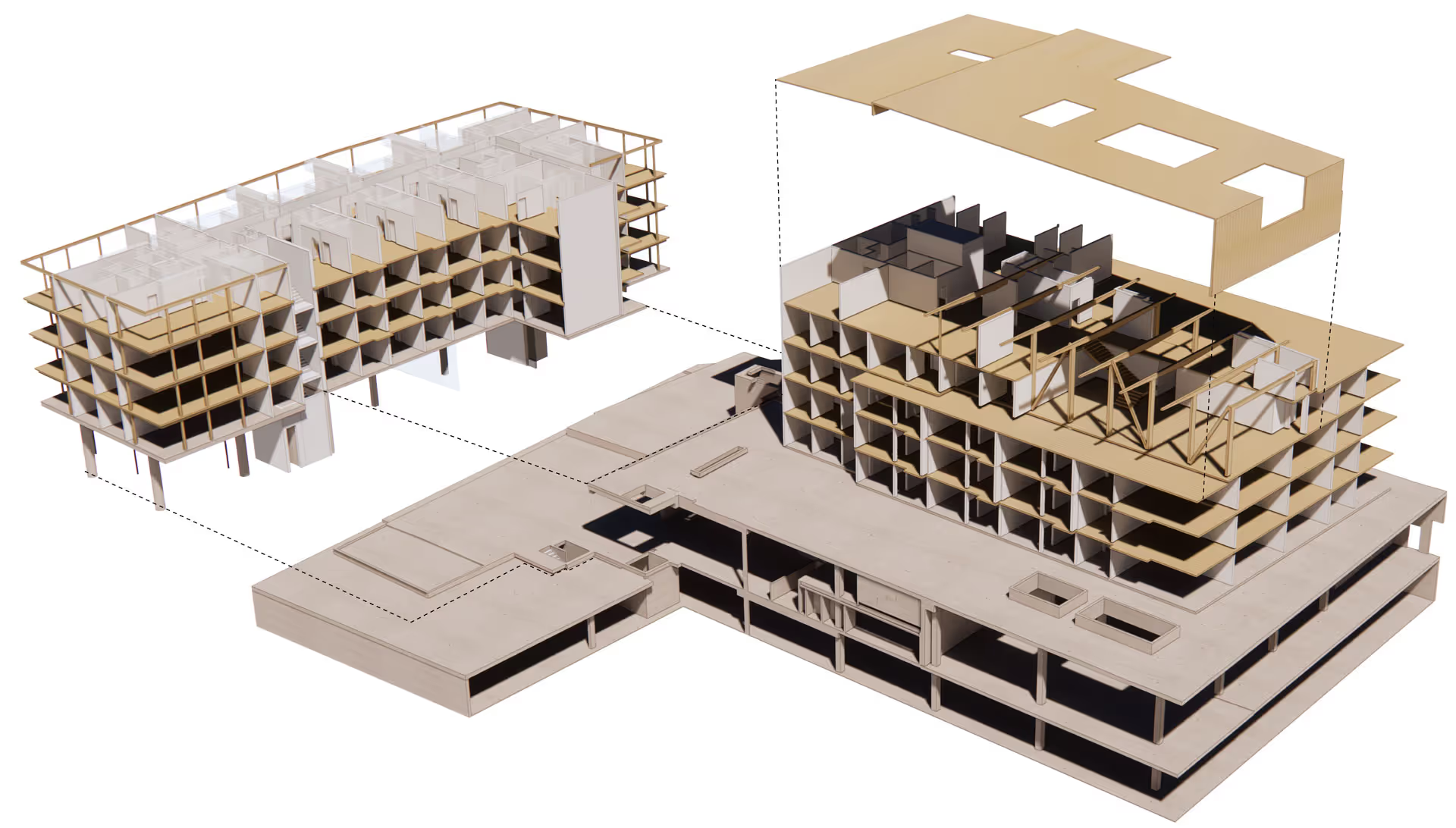Mass Timber: Reimagining an age-old resource
Promoting a new technology requires education in a slow-to-adopt building industry

Dean Lewis became intrigued by mass timber as a viable new building material option when he saw its benefits in action. As an engineer with DCI in San Francisco, he and his team were encouraged to incorporate more environmentally conscious methods into their latest construction projects.

“To keep costs down and enhance the aesthetic of the building, we proposed expanding the role of prefabricated cross-laminated timber (CLT) panels” says Dean. “The developer loved the innovative idea and the footprint of CLT grew from small areas of buildings into the entire structure. The possibilities are endless.”
Since then, he has worked at Swinerton’s mass timber group and a mass timber prefabrication start up at Sidewalk Labs before heading up Skanska’s mass timber division across the U.S., leading his team to integrate the relatively new technology into the consciousness of the building industry.
When you think about innovative building materials, timber might not be the first thing that comes to mind. Humans have long had a symbiotic relationship with the forest and with wood since the first lean-to was constructed thousands of years ago. It’s always been a dependable construction component known for its durability, flexibility and accessibility.
As demand for greener alternatives to concrete and steel has grown, mass timber, which has been used for more than twenty years in Europe and Canada, is now gaining momentum in America. No longer marginalized to second-class duties like light framing or finishing, it is proving itself as a smart alternative to its carbon-intensive counterparts.
What is Mass Timber?
Mass timber is an advanced engineering process that cross laminates layers of wood and then glues, nails or dowels them together to create surprisingly strong and versatile building components. The results are so sturdy and dependable they can be used for posts, beams, walls and other load-bearing structural materials like long-spanning roof structures and even high-rise buildings up to 18 stories tall.
“Building areas and heights are expanding which open up the potential,” reports Dean. “This is a huge game changer for its practicality and feasibility in construction.”
Not only is mass timber the only building material regularly regenerated by the sun, it can be prefabricated with laser precision and installed easily in a fraction of the time it takes for alternative methods.
With everything going for it, headwinds still exist to adoption at scale. A common issue for mass timber due to the building codes is builders risk insurance.
“Skanska has completed more than a dozen successful projects to date including the current expansion and nine-acre mass timber roof now in installation at the Portland (OR) International Airport, one of the largest mass timber projects in the country,” says Dean. “But this is a risk averse industry and without enough data to justify the risk, the insurance industry and other industry partners are reluctant to quickly adopt new technologies.”
To grow awareness and flatten stigmas, Dean and his team rely heavily on the power of education. It is the most effective marketing tactic in the building industry - whether you are converting perceptions about an emerging technology, getting in front of new business opportunities or attracting prospective team members to your firm.
Owners and project leads are often overloaded and may not know the new possibilities of mass timber. They are more likely to consider a product like mass timber (or the services of a prospective vendor) when presented with bite-sized learning opportunities about its advantages on a regular basis.

Addressing the 'Missing Middle'
Ted Panton (AIA, NCARB), is a Principal Architect of GGLO who leads the design and permitting process for The Gardens District, an extensive mixed-use project in Woodinville, Washington. The project features 82 residential units constructed with dowel-laminated timber, a form of mass timber. He is a big proponent of the material, regularly speaking at industry conferences about its existential benefits.
“Mass Timber is a value-add for apartments as it conveys the warmth and tactility of wood along with its inherent sustainability,” says Ted. “It offers the opportunity to build urban density with a robust and durable material that will last generations, while contributing to much-needed housing inventory.”
Promotion Through Education
Both Dean and Ted report much of their marketing efforts are conducted on the grassroots level by attending conferences and answering questions that developers or other construction leaders might have.
“We trade stories and ideas,” Dean says. “Most industry professionals become converts to mass timber once they take a chance on the concept. It's our job to spread the word and encourage them to continue to evolve and advance its potential.”
Being an example of innovation in action is sure to appeal to younger talent considering the next step in their careers. Prospective project managers or engineers are drawn to companies who are visionary with a higher sense of purpose. Finding teaching opportunities about the technology is a more productive conversation starter at job fairs or technical schools.
“Potential and current team members resonate with mass timber being an important step in reaching Skanska’s division-wide goal of achieving net-zero carbon emissions by 2045,” reports Dean.
Valued for its natural beauty, strength, warmth and sophistication, mass timber offers endless possibilities in the building industry. The material and process are only in their infancy but with a mix of education and successful project examples, the technology is sure to become a more prominent product in the near future.
“Humans are known to perform better in a natural environment surrounded by wood,” Ted says. “It's one building material that improves the value of its surroundings the more you keep it exposed.”

Written by Rusty George with zero help from AI Chatbots.
Rusty George leads a branding, website design and marketing agency serving Seattle and Tacoma area construction companies, subcontractors, engineering and architecture firms, material fabricators and suppliers. His goal is to help the building industry become more attractive to the skilled workforce of the future.
Images courtesy Skanska and GGLO
MORE Insights
Unlock the secrets to transforming your construction company into a marketing powerhouse with Louder Builder.

Small Moves Now. Big Wins Next Year

SEM: You Can’t Win Work If You Can’t Be Found
SIGN UP FOR UPDATES
We will send you our latest insights from Louder Builder as they are released.
CONTACT US
Are you ready to begin your project today? Just have a few questions?
Either way, let’s talk.
